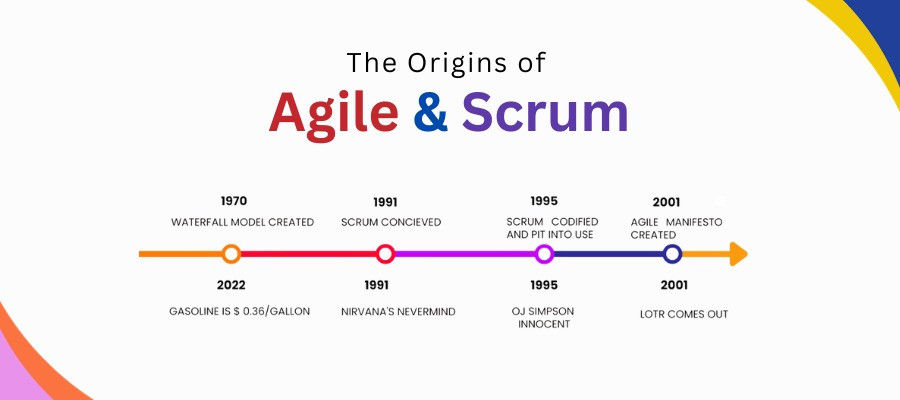The Origins of Agile & Scrum

Today, Agile and Scrum are indispensable as project management frameworks. But, many argue that they both have been around for a while now. As they continue driving efficiency and customer satisfaction, today’s Agile Practitioners are excited to unveil the origins of Agile and Scrum! Indeed, It is a fascinating tale of evolution that ends at global prominence. Now, it’s your turn to review the evolution of Agile and Scrum as an Agile Beginner!
Agile's Early Roots With Toyota's Lean Manufacturing:
The journey begins with the manufacturing practices of Toyota in 1945. Toyota pioneered a new working method, emphasizing autonomy, transcendence, and cross-fertilization among teams. This approach, later identified in the "New New Product Development Game" by Hirotaka Takeuchi and Ikujiro Nonaka in 1984, laid the groundwork for what would become Scrum.
Ken Schwaber, a former corporate worker frustrated with the inefficiencies of traditional project management, sought change in the industry. Following DuPont's advanced process control methods, Schwaber advocated for shorter planning periods and iterative development. This concept aligned with Toyota's approach and set the stage for the birth of Scrum.
Scrum Takes Flight With The Formation of First Scrum Team:
In 1994, Jeff Sutherland, the Chief Engineer at Easel Corporation, embraced the challenge of developing a new product faster and better than existing market offerings. Drawing inspiration from Takeuchi and Nonaka's holistic approach, Sutherland and his team implemented a new framework for software development: Scrum.
The first Scrum team, established in January 1994, followed the principles outlined in the "New New Product Development Game." Sutherland emphasized the importance of self-organizing teams, making work visible, and giving teams the responsibility to fix problems. The success of this approach prompted Sutherland and Schwaber to expand Scrum beyond Easel Corporation.
Formalizing Scrum: The Birth of Agile Manifesto
In 1995, at the OOPSLA'95 conference, Schwaber and Sutherland officially introduced Scrum. This marked a turning point as Scrum gained traction in various industries, including Motorola, Fidelity, and GE Medical. The real breakthrough came in 2001 when Schwaber and Sutherland, along with other thought leaders, co-created the Agile Manifesto, providing a set of principles and values to guide creative work in the product development industry.
Hence, in 2001, when the thought leaders gathered in Utah, yhis meeting resulted in the Agile Manifesto, a pivotal moment in Agile history. The Agile Manifesto insisted values such as "Individuals and interactions over processes and tools" and "Customer collaboration over contract negotiation." This new approach was in stark contrast to the traditional, rigid project management methods of the past.
Agile in the 21st Century: The Revolution Continues
The Agile Manifesto set the stage for adopting Agile practices in various industries. With their focus on customer-centricity, flexibility, and continuous improvement, Agile principles began gaining traction in software development. Teams worldwide started adopting Agile methodologies, paving the way for more focused and adaptive project management.
As Agile gained momentum, various frameworks, and certifications emerged to support its implementation. The Certified Scrum Master (CSM) and Certified Scrum Product Owner (CSPO) designations became synonymous with expertise in Scrum. Organizations like Scrum Alliance and PremierAgile were pivotal in promoting Scrum and Agile practices.
The 3 accountable roles of Scrum Master, Product Owner, and Developers became integral to the Scrum Team, each contributing to the iterative and incremental development process. The Product Backlog, Sprint Backlog, and Increment became essential artifacts, ensuring transparency and adaptability throughout the development cycle.
Scrum Emerges as a Leading Framework:
Scrum is a framework that emphasizes teamwork, accountability, and iterative development. It is based on the concept of small, self-managing teams composed of a Scrum Master, Product Owner, and Developers. The Scrum Team works with the Product Backlog, a prioritized list of items representing features, enhancements, or bug fixes. Each item is called a Product Backlog Item (PBI) and is usually expressed as a User Story.
Now, let's fast forward to 2020 when the latest version of the Scrum Guide was rolled out. This update reflected the evolving needs of Agile practitioners and incorporated new insights from the Agile community. The Scrum Guide continues to be the definitive resource for Scrum teams, helping them maintain alignment with Agile principles.
The Agile Practitioner's Journey As Of Today:
Many companies embarked on Agile transformations as Agile and Scrum became more mainstream. Agile Coaches and Agile Leaders played crucial roles in helping organizations navigate this journey. Workshops and coaching sessions became integral in assisting teams to adapt to Agile methodologies.
Whether you're an Agile beginner or an experienced Agile Product Owner, adopting Agile and Scrum is a continuous learning process. Agile Developers play a vital role in adapting to new methodologies and ensuring the successful implementation of Agile practices within their teams.
PremierAgile brings you a comprehensive platform for learning and development. PremierAgile provides the guidance and resources needed to thrive in Agile, from foundational Agile principles to advanced Scrum techniques. So, begin your learning journey today with PremierAgile and unlock the full potential of Agile practices in your organization.
Reference:
https://www.ScrumAlliance.org
https://www.Scrum.org



